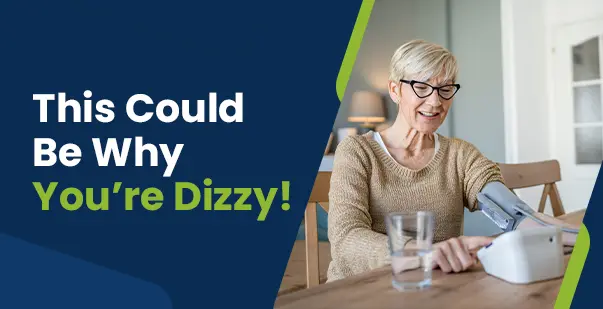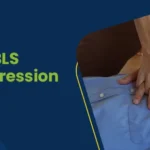Table of Contents:
- What Is Hypotension?
- Types of Low Blood Pressure
- Low blood pressure symptoms
- What Can Cause Low Blood Pressure?
- Medications That Can Cause Low Blood Pressure
- Recognizing Dangerous Signs of Low Blood Pressure
Could low blood pressure be the reason you feel dizzy or lightheaded, especially when you stand up suddenly? You’re not alone. Research shows that about 22% of adults aged 60 and over experience this condition based on routine blood pressure checks. While low blood pressure is often harmless in healthy individuals, it can sometimes lead to serious complications such as confusion, fatigue, or shock. This guide will explain what causes low blood pressure and when to see a doctor in case you have low blood pressure.
What is Hypotension?
Hypotension, or low blood pressure (LBP), occurs when the force of blood against the artery walls is lower than normal. A normal blood pressure reading is around 120/80 mmHg. Hypotension is generally defined as having a reading below 90/60 mmHg.
While some people have naturally low blood pressure with no symptoms, hypotension can become serious if it reduces blood flow to vital organs like the brain, heart, and kidneys. Recent research shows that about 10–11% of adults with hypotension who come to the emergency room die during their hospital stay. And so, there is an urgent need for early recognition and quick treatment to prevent complications.
Read More: Blood Pressure & Heart Rate: Relationship & Differences
Types of Low Blood Pressure
Low blood pressure can occur for various reasons and may not always be harmful. However, when it affects the normal blood flow, it can lead to dizziness, fainting, or even organ damage. Understanding the different types of hypotension and what causes them aids in proper diagnosis and treatment. The table below outlines the main types of low blood pressure, their causes, and their effects.
| Type of Low Blood Pressure | Description | Common Cause/Who It Affects | Symptoms |
| Normal Hypotension | Naturally low blood pressure without symptoms. The body manages healthy blood flow efficiently. | Healthy individuals with good circulation. | There are no symptoms seen. Sometimes, dizziness or fainting may be present. |
| Orthostatic Hypotension (Postural Hypotension) | It is a sudden drop in blood pressure after standing up due to gravity pulling blood downward. | Affects older adults, dehydrated individuals, and people on certain medications like diuretics, beta-blockers, etc. | The main symptom is dizziness, fainting while standing up. |
| Postprandial Hypotension | It is a drop in blood pressure after eating as blood flows to the digestive tract. | Affects older adults, people with nervous system disorders. | Dizziness or fainting after meals. |
| Neurally Mediated Hypotension (NMH) | It occurs due to the miscommunication between the brain and heart; the brain wrongly signals the heart to slow down. | Commonly seen in children and young adults. | Fatigue, dizziness, and fainting, especially after standing or stress. |
Low Blood Pressure Symptoms
Low blood pressure symptoms can vary from mild to severe, and they also differ from person to person. Some of the most common low blood pressure symptoms in men and women are:
- Dizziness or lightheadedness: This occurs when the brain receives less blood and oxygen due to low blood pressure (hypoperfusion). It can make a person feel unsteady or as if they might faint.
- Fainting (syncope): Syncope is a temporary loss of consciousness caused by a sudden drop in cerebral perfusion. When blood pressure drops too low, the brain does not get enough oxygen, leading to brief fainting episodes.
- Blurred vision: Blurred vision happens when reduced blood flow affects the eyes and optic nerve. Low pressure can interrupt normal visual processing, making things appear fuzzy or out of focus temporarily.
- Nausea: Low blood pressure may reduce blood flow to the digestive tract, affecting how the stomach functions. This can cause nausea or a queasy feeling, especially when standing or after eating.
- Fatigue: Fatigue occurs when organs and muscles receive less oxygen-rich blood, reducing energy production at the cellular level. Chronic hypotension may leave people feeling weak and constantly tired.
- Difficulty concentrating: This is also called “brain fog.” In hypotension, the brain may not get enough oxygen and nutrients, which can affect memory, alertness, and focus, especially during mental tasks.
- Rapid, shallow breathing: Low blood pressure can trigger a faster respiratory rate (tachypnea) as the body tries to bring in more oxygen. Shallow breathing is often a sign that the body is under stress.
- Weak or rapid pulse: A weak or fast pulse (tachycardia), defined as a heart rate over 100 beats a minute, occurs as the heart tries to compensate for low blood pressure. This helps maintain blood flow, but can be a warning of circulatory instability.
Now that we know the different types of hypotension, let us see what causes hypotension.
Are There Any Specific Low BP Symptoms In Women?
Yes, low blood pressure symptoms in women can be similar to those in men but may sometimes present differently due to hormonal fluctuations, pregnancy, or menstrual cycles. Symptoms unique to women include dizziness, fainting, blurred vision, nausea, feeling weak or shaky, and mood changes or irritability due to hormonal shifts. Women may also experience cold or clammy skin, difficulty concentrating, brain fog, and headaches.
During pregnancy, low blood pressure is common due to increased blood volume and hormonal changes. This can cause dizziness, especially when standing up quickly. Some women may also feel lightheaded during their menstrual cycle due to temporary drops in blood pressure. If symptoms of low BP in females become severe, such as persistent fainting, confusion, or chest pain, immediate medical attention is needed.
Low Blood Pressure Death Symptoms
Low blood pressure death symptoms occur when blood pressure drops to dangerously low levels, preventing vital organs from receiving enough oxygen. This can lead to shock, organ failure, and death if not treated immediately. Common symptoms include extreme dizziness, confusion, rapid breathing, and cold, clammy skin. In some cases, these symptoms may progress to end-of-life signs, such as:
- Noisy or irregular breathing (death rattle)
- Body temperature dropping (hypothermia) and skin turning bluish (especially hands and feet)
- Unresponsiveness to touch or voice
- Eyes partly open and glassy
- Very low or undetectable blood pressure and pulse
These signs indicate the body is shutting down. Immediate medical care is vital if a person shows these symptoms. Without treatment, the condition can quickly become fatal.
What Can Cause Low Blood Pressure?
Low blood pressure can happen for many reasons, and sometimes, it’s a sign that something isn’t right in the body. When blood pressure drops too low, the brain and other organs may not get enough oxygen, leading to dizziness, fainting, or even serious complications. The common causes of low BP are:
-
Dehydration
Dehydration happens when the body loses more water than it takes in. Water is essential for maintaining blood volume, and when levels drop, blood pressure falls. This can lead to dizziness, weakness, and fainting. Some common causes of low blood pressure include losing too much fluid through heavy sweating, ongoing diarrhea, frequent vomiting, or simply not drinking enough water. These situations can leave your body dehydrated, making it harder for your heart to pump blood effectively.
-
Heart Problems
The heart pumps blood throughout the body, and any heart condition that weakens this function can lower blood pressure. Conditions like heart failure, bradycardia, or valvular diseases can significantly reduce blood flow, leading to decreased oxygen delivery to organs and symptoms like fatigue and dizziness. For instance, heart failure affects approximately 64 million people globally, with an overall prevalence of over 10% in those above 75 years of age. This highlights the common and serious heart-related causes of low blood pressure, especially in older adults.
-
Endocrine Disorders
Hormones regulate many body functions, including blood pressure. For example, adrenal insufficiency, such as Addison’s disease, results in decreased production of cortisol and aldosterone. These hormones are responsible for maintaining blood pressure and electrolyte balance.. In addition, low blood sugar (hypoglycemia) can also affect circulation. These hormonal and metabolic imbalances disrupt normal blood vessel function, potentially causing blood pressure to drop to dangerously low levels.
-
Severe Infections (Septicemia)
Septicemia, or sepsis, is a dangerous infection that spreads through the bloodstream and affects the whole body. When this happens, the immune system overreacts and causes the blood vessels to widen too much. As a result, blood pressure drops suddenly, and there’s not enough oxygen reaching vital organs like the brain, heart, and kidneys. Without quick medical treatment, sepsis can lead to shock, organ failure, or even death.
-
Blood Loss
Losing a large amount of blood, whether from an external injury or internal bleeding, reduces blood volume. Since blood carries oxygen and nutrients, a sudden loss can lower blood pressure drastically, causing mild side effects like nausea, increased heart and respiratory rates, decreased urine output, and lowered blood pressure. When blood loss exceeds 40%, systolic pressure can drop below 70 mm Hg, which may lead to unconsciousness.
-
Nutrient Deficiencies
Essential nutrients like vitamin B12, folate, and iron help produce healthy red blood cells. These cells transport oxygen throughout the body. A deficiency in these nutrients can lead to anemia, reducing the amount of oxygen in the bloodstream. This can cause low blood pressure, fatigue, and dizziness.
Read More: Identify Differences: Heat & Dehydration with signs and advice.
Now that we know what can cause low blood pressure, let us see some medicines that cause low BP.
Medications That Can Cause Low Blood Pressure
According to a 2021 review in Drugs & Aging, nearly 30% of adults over 65 experience low blood pressure as a side effect of medication, which can increase the risk of falls and related complications. While these drugs are often necessary for treating various conditions, they can have side effects that affect circulation. The medications are cause low blood pressure are:
-
Diuretics (Water Pills)
Diuretics help remove extra fluid and salt from the body, lowering blood pressure. However, losing too much fluid can decrease blood volume, leading to low blood pressure.
-
Beta-Blockers
Also written as β-blockers, they reduce blood pressure by slowing the heart rate and decreasing the force of heartbeats. This lowers oxygen demand but can sometimes reduce blood pressure too much.
-
Alpha-Blockers
Alpha-blockers relax blood vessels, making it easier for blood to flow. They are used to treat high blood pressure and prostate conditions. However, they can cause a sudden drop in blood pressure, leading to dizziness or fainting, especially when standing up after sitting or lying down.
-
Antidepressants
Some antidepressants, like tricyclics and monoamine oxidase inhibitors (MAOIs), can lower blood pressure by relaxing blood vessels. People taking these medications should monitor their blood pressure to avoid complications from sudden drops.
-
Drugs for Parkinson’s Disease
Medications like levodopa improve movement by increasing dopamine levels in the brain. However, they also widen blood vessels, which can lower blood pressure too much.
-
Narcotics and Alcohol
Narcotics and alcohol depress the central nervous system, slowing the heart rate and relaxing blood vessels. Drinking alcohol excessively or using narcotics can dangerously lower blood pressure, increasing the risk of shock or unconsciousness.
Recognize Dangerous Signs of Low Blood Pressure!
Low blood pressure isn’t always harmful, but it becomes dangerous when it causes symptoms like dizziness, fainting, confusion, blurred vision, or signs of shock. These symptoms suggest that the brain and vital organs may not be getting enough oxygen. Knowing what causes low blood pressure, like dehydration, blood loss, or medication side effects, can help you take necessary steps to prevent serious health risks. Be alert for red flags that require urgent attention, including cold, clammy skin, chest pain or shortness of breath, and fainting more than once. If you or someone you know notices these symptoms, especially if they occur frequently, seek medical help immediately.
In emergencies like hypovolemic shock, quick action can save lives. Learning Advanced Cardiac Life Support (ACLS) gives you the skills to handle situations like shock and heart failure. Want to be prepared? Sign up for an ACLS course today!







